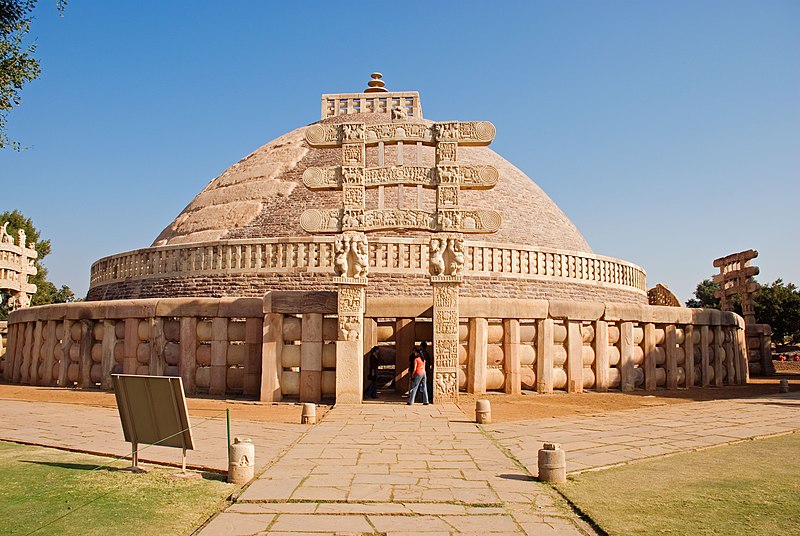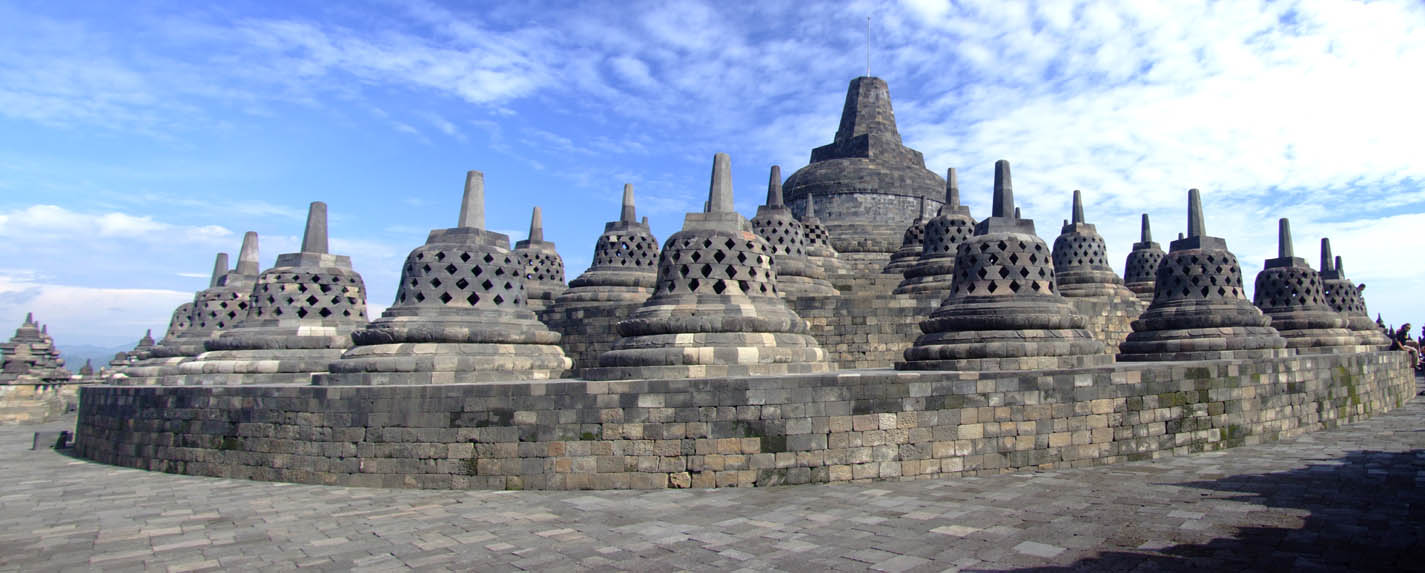Introduction
Stūpas, often also known as caityas,1 are reliquary monuments characteristic of Buddhist sites, originally in the form of mounds housing bodily remains, relics, or cremated ashes. The first Buddhist stūpas were those constructed to house the Buddha’s relics, which were divided into eight or ten portions taken to different regions. The relics they contained were later distributed more widely, particularly during the reign of Aśoka, and housed in a large number of stūpas constructed all over the Indian subcontinent and Central Asia.
Arhats and other teachers and important monastic officials also came to be commemorated in stūpas, and the site of a venerated stūpa often became the nucleus of a monastery or center of learning, attracting pilgrims and devotees, forming a focus for practice and worship, and providing offerings for the saṅgha.
As the construction of stūpas developed over time and in different regions, a number of different traditional forms evolved. Stūpas usually have a round or square, stepped base (medhi), a rounded dome or bulb-shaped “vase” (Skt. anda, Tib. bum pa) body, and a tiered canopy or parasol (chatra) above an upper enclosure (harmika). Many traditional stūpas are built around a central, wooden axis called the “life tree” (yaṣṭi, srog shing). Stūpas may be surrounded by a latticed railing (vedika, lan kan) within which is a passage for circumambulation (prādakṣiṇapatha, skor lam). The elements of stūpa architecture have taken on a rich symbolism.
The architecture of both pyramidal temples (like the Mahābodhi Temple in Bodh Gaya) and pagoda towers is also derived from the stūpa form.
Stūpas are built in stages following extensive ritual procedures and consecration ceremonies. They house not only funereal relics but also hair, nails, clothes and other personal belongings, statues, jewels, medicinal substances, sacred texts, and rolled up sheets of written mantras and dhāraṇīs. They may be built over a base under which weapons are buried (symbolizing the overcoming of war and conflict) and containing “wealth vases” (for the increase of prosperity and wellbeing).
Notable Mentions of Stūpas in Kangyur Texts
1) Benefits of building stūpas:
2) Benefits of venerating stūpas:
This is the main theme of:
The Avalokinī Sūtra (Toh 195) cf also the parallel passages in the Mahāvastu and quotes in the Śikṣāsamuccaya.
Verses on Circumambulating Reliquaries (Caityapradakṣiṇagāthā, Toh 321)
It is mentioned in passages in:
3) Texts Used in Rituals for Construction and Consecration:
The “two stainless ones” (dri med rnam gnyis), which are:
The Incantation of the Pure Stainless Light (Raśmivimalaviśuddhaprabhādhāraṇī, Toh 510)
The Incantation of Vimaloṣṇīṣa (Samantamukhapraveśaraśmivimaloṣṇīṣaprabhāsasarvatathāgatahṛdayasamayavilokita-nāmadhāraṇī, Toh 599)
A number of other texts mention the closely related topic of making miniature stūpas or tsha tsha, an activity which has its own symbolic meaning and beneficial results:
The Dhāraṇī for a Caitya (Caityadhāraṇī, Toh 601)
The Sūtra on Dependent Arising (Pratītyasamutpādasūtra, Toh 212)
Related material and commentaries in Tengyur (Toh 2688, 3068-9, 3079, 3081-2) and Nyingma Kahma vol. 2.
4) Other Mentions of Stūpas in Kangyur Texts:
Stūpas of the six buddhas of the past in the Heaven Free from Strife, in The Application of Mindfulness of the Sacred Dharma (Toh 287), 4.C.2656 et seq.
The Eight Stūpas Related to the Buddha’s Life
1. Heap of Lotuses or Bringer of Auspiciousness Stūpa (pad spungs / bkra shis ’byung ba’i mchod rten)
The Buddha Śākyamuni, on the seventh day of the fourth month, Vaiśākha (Saga Dawa), took birth in the Lumbinī grove near the city of Kapilavastu. The stūpa honouring this occasion was built by his father King Śuddhodana and others, and is known as the Heap of Lotuses Stūpa.
2. Subjugation of Māra or Great Enlightenment Stūpa (bdud btul / byang chub chen po’i mchod rten)
The Buddha Śākyamuni, at the age of thirty-five, on the fifteenth day of the fourth month, Vaiśākha (Saga Dawa), attained complete and perfect enlightenment beneath the Bodhi Tree in Vajrāsana (Bodhgaya). The stūpa honouring this occasion was built by King Bimbisāra and others, and is known as the Subjugation of Māra Enlightenment Stūpa.
3. Many Auspicious Gateways Stūpa
The Buddha Śākyamuni, at the age of thirty-five, on the fourth day of the sixth month, Āṣāḍha, turned the Wheel of the Dharma of the Four Truths in the Ṛṣipatana Deer Park in the region of Vārāṇasī. The stūpa honouring this occasion was built by the Five Excellent Disciples, and is known as the Many Auspicious Gateways Stūpa.
4. Miracles Stūpa
The Buddha Śākyamuni, at the age of fifty, on the first fifteen days of the first month, Māgha, outperformed the māras and non-Buddhist teachers in the Jetavana Grove in Śrāvastī. The stūpa honouring this occasion was built by the Licchavis, and is known as the Miracles Stūpa.
5. Descent from the Heavens Stūpa
The Buddha Śākyamuni, at the age of forty-two, after spending the rains retreat in the Tuṣita god realm to repay the kindness of his mother, on the twenty-second day of the ninth month, Āśvina, returned to the human realm in the city of Saṃkāśya. The stūpa honouring this occasion was built by the inhabitants of the region, and is known as the Descent from the Heavens Stūpa.
6. Settling of Disputes Stūpa
While the Buddha Śākyamuni was residing in the Veṇuvana Grove at Rājagṛha, the two supreme disciples [Śāriputra and Maudgalyāyana] resolved the schism in the saṅgha created by Devadatta. The stūpa honouring this occasion was built by the Prince and other Magadhans, and is known as the Settling of Disputes Stūpa.
7. Victory Stūpa
The Buddha Śākyamuni, in his eightieth year of age, on the fifteenth day of the third month, Chaitra, having said that his physical body would pass away, granted in Vaiśālī the blessing of extending his life by three months, as the layman Cunda had requested him. The stūpa honouring this occasion was built by the gods, and is known as the Victory Stūpa.
8. Parinirvāṇa Stūpa
The Buddha Śākyamuni, at the age of eighty-one, on the fifteenth day of the fourth month, Vaiśākha (Saga Dawa), manifested the apparent parinirvāṇa of his physical body in the city of Kuśinagarī, and the stūpa built there by the Mallas is known as the Parinirvāṇa Stūpa.
Stūpas as Representations of the Tathāgata’s Body, Speech, and Mind
Body
As monuments housing the relics of a tathāgata, or of arhats and other awakened individuals, stūpas most obviously represent the body of the tathāgata.
Speech
The statements of places where a scripture is recited, read or upheld “becomes a caitya” / “becomes like a caitya,” see Schopen 2005.
Mind
In representing the continued presence of the tathāgata, stūpas also embody the awakened state and hence mind. In the Tibetan tradition of offering supports of body, speech, and mind to a teacher during ritual offerings for longevity (brtan zhugs), a small stūpa is used to symbolize the adamantine mind.
Other Well-known Stūpas
A stūpa in present day Madhya Pradesh that may have been built by one of Aśoka’s queens and was an important site of practice and pilgrimage from the third century ʙᴄᴇ to the twelfth century ᴄᴇ. It housed relics that may have been those of Śāriputra and Maudgalyāyana.
Amarāvati (’chi med ldan)
Known historically as Dhānyakaṭaka and situated in modern Andhra Pradesh, another stūpa built in Aśoka’s reign. It was the largest stūpa in India, and Dhānyakaṭaka became the capital of the southern Sātavāhana dynasty in the third century ᴄᴇ. It is also the place where the Buddha is traditionally said to have taught the Kālacakratantra.
Bhārhut
Another stūpa built in Aśoka’s reign, famous for its bas-relief images.
Gandhāra stūpas
A large number of stūpas were built in the Gandhāra region, probably from Aśoka’s time onwards. It seems to have been in Gandhāra that many of the forms of stūpa known today eveolved.
Gomasalaganda
The legendary stūpa on the Gośṛṅga hill in Khotan, blessed by the Buddha Śākyamuni and the four previous buddhas, as described in The Prophecy on Mount Gośṛṅga (Toh 357). Its probable site may be surmised but there is no trace today.2
The Three Stūpas of the Kathmandu Valley
The Great Stūpa in present-day Bauddhanath to the east of Kathmandu, center of a thriving community of Tibetan monasteries and Tibetans in exile. It is said to house the relics of the Buddha Kāśyapa, but historically speaking may date to the reign of King Mānadeva I in the late fifth century ᴄᴇ. According to a famous gter ma text detailing the legend of the stūpa’s construction during Kāśyapa’s dispensation, those who built the stūpa—the sons of the poultry-woman Śamvara, along with other characters in the legend—thereby created the karmic seeds for their rebirth as King Trisong Detsen, Padmasambhava, Śāntarakṣita, and other key figures in the propagation of Buddhism to Tibet.
The stūpa on top of a hill to the west of Kathmandu, sacred to Newar and Tibetan Buddhist traditions, and said to date from the dispensation of the Buddha Vipaśyin, through a legend concerning Mañjuśrī’s draining of a lake filling the valley that parallels (and may represent a mislocation of) the legend of the Gomasalaganda stūpa and the Gośṛṅga hill in Khotan.3 Historical records start with the fifth century reign of King Vṛṣadeva.
3) Namobuddha (stag mo lus sbyin)
Built at a hillside site in the Kathmandu valley southeast of Kathmandu where, according to legend, the Buddha in a previous life as a local prince fed his own body, out of compassion, to a starving tigress so that she could feed her cubs.
A massive temple complex on the Indonesian island of Java, built in the late eighth century. the complex has the layout of a maṇḍala, centered on a large stūpa surrounded by seventy-two smaller ones. In theme it appears to be linked to the narrative of the apprentice bodhisattva Sudhana in the Gaṇḍavyūha.




